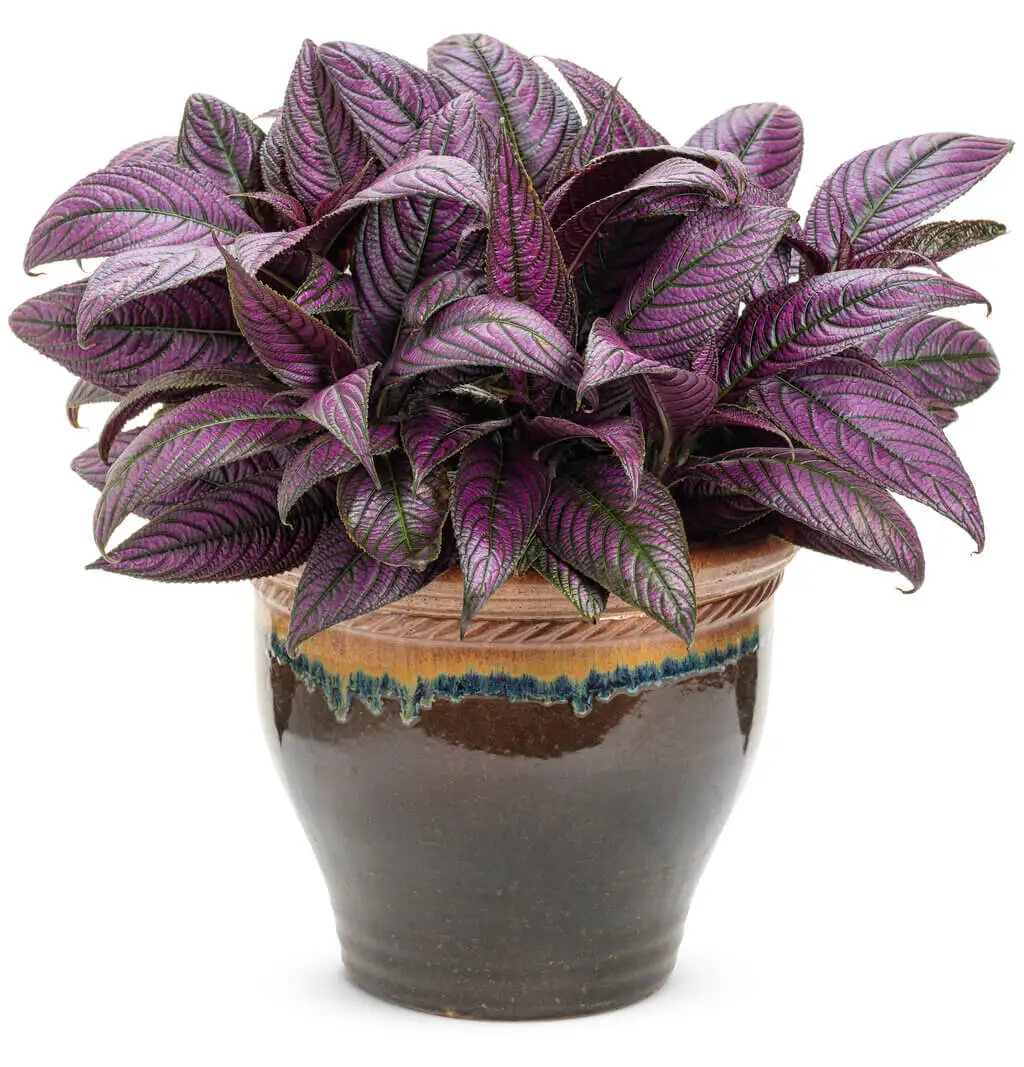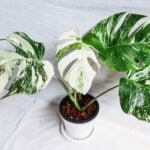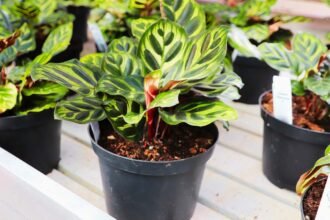Add visual interest and textural contrast to your garden or indoor environment by including plants with colorful foliage. Choose plants with purple and green leaves if you want to draw attention to yourself.
You may use these plants as either showpieces or supporting cast members in your garden design thanks to their versatile sizes and shapes. 9 of the most beautiful plants with purple and green leaves are discussed in this article, along with information on how to care for them and what they need to thrive.
Purple and green are, in fact, opposites on the color wheel. That’s why you should utilize them together; the resulting contrast is stunning. Studies have revealed that people are more likely to take notice of plants with colorful foliage than those with standard green leaves.
Purple and green plants are also preferred for indoor settings due to the relaxing effect they have on humans. These purple and green leafed plants will make a bold impression in any setting, from the outdoors to the living room.
1. Persian Shield (Strobilanthes dyerianus)
This tropical plants features stunning metallic purple leaves with green veins. It thrives in warm, humid environments and can grow up to three feet tall. Persian Shield is a popular choice for gardens and indoor spaces alike.
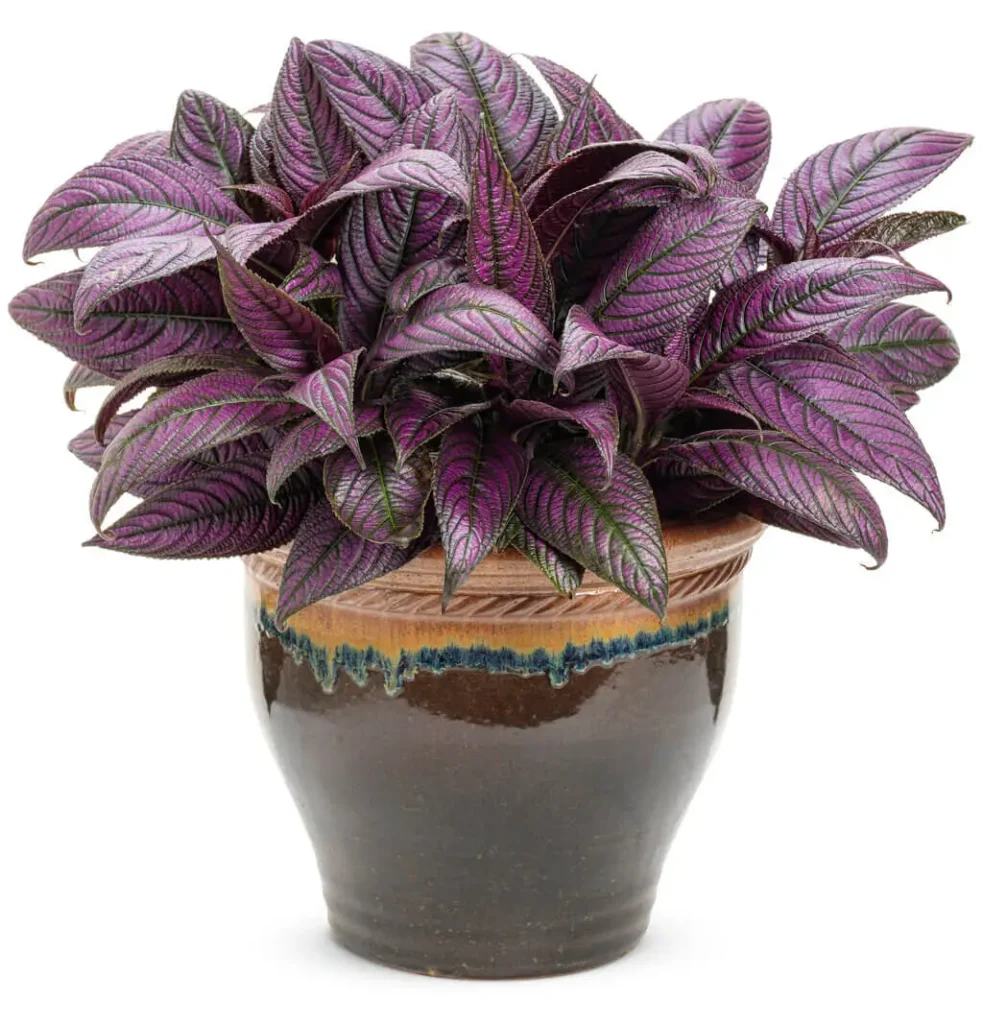
| Feature | Description |
|---|---|
| Scientific name | Strobilanthes dyerianus |
| Common names | Persian Shield, Royal Purple Plant, Purple Velvet Plant, Strobilanthes, and Exotica |
| Plant type | Herbaceous perennial |
| Foliage color | Shimmering purple, silver, and green leaves |
| Leaf shape | Large and lance-shaped leaves |
| Mature size | Can grow up to 3-4 feet (90-120 cm) tall and wide |
| Bloom time | Rarely blooms, but produces tubular purple flowers in late fall or early winter |
| Light requirements | Needs bright, indirect light or partial shade |
| Soil requirements | Well-draining soil, enriched with organic matter, and slightly acidic (pH 5.5-6.5) |
| Watering needs | Moderate watering, allow the soil to dry partially between watering sessions |
| Temperature | Thrives in warm temperatures between 60°F (15.5°C) and 85°F (29.5°C) |
| Humidity | Prefers high humidity levels above 50% but can tolerate lower levels |
| Toxicity | Non-toxic to humans and pets, but ingestion may cause mild stomach discomfort |
2. Coleus (Solenostemon scutellarioides)
Coleus plants come in a wide range of colors and patterns, but many varieties feature leaves that are purple, green or a combination of both. These plants are easy to grow and can thrive in a variety of lighting conditions.
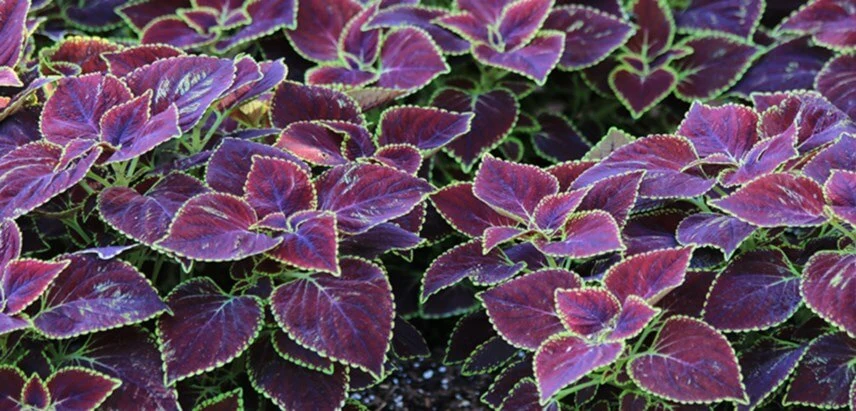
| Feature | Description |
|---|---|
| Scientific name | Solenostemon scutellarioides (formerly Coleus blumei) |
| Common names | Coleus, Painted Nettle, Poor Man’s Croton, Flame Nettle, and Joseph’s Coat |
| Plant type | Herbaceous perennial |
| Foliage color | Comes in a wide range of colors and patterns, including green, purple, pink, red, yellow, and white |
| Leaf shape | Wide and flat, with scalloped or toothed edges |
| Mature size | Can grow up to 2-3 feet (60-90 cm) tall and wide |
| Bloom time | Produces small, insignificant flowers in spikes in late summer or early fall |
| Light requirements | Needs bright, indirect light or partial shade, can tolerate some direct sun |
| Soil requirements | Well-draining soil, enriched with organic matter, and neutral to slightly acidic (pH 6.0-7.0) |
| Watering needs | Moderate watering, allow the soil to dry partially between watering sessions |
| Temperature | Thrives in warm temperatures between 60°F (15.5°C) and 75°F (24°C), can be damaged by frost or extreme heat |
| Humidity | Prefers high humidity levels, and can be grown indoors or outdoors with proper care |
| Toxicity | Non-toxic to humans and pets, but ingestion may cause mild stomach discomfort. Some people may experience skin irritation from handling the leaves. |
3. Oxalis (Oxalis triangularis)
Also known as the purple shamrock, this plant features deep purple leaves with triangular-shaped leaflets. It produces delicate pink or white flowers and is popular as a houseplant.
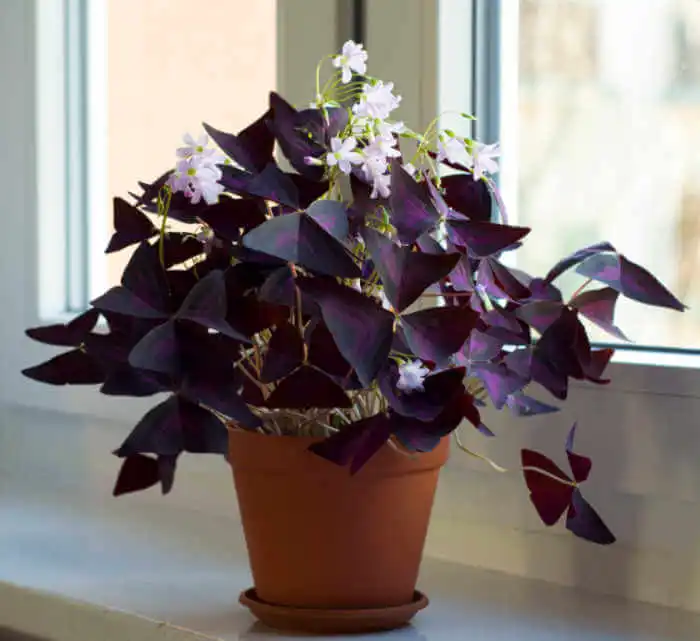
| Feature | Description |
|---|---|
| Scientific name | Oxalis spp. |
| Common names | Oxalis, Wood Sorrel, False Shamrock, and Buttercup Oxalis |
| Plant type | Herbaceous perennial or annual |
| Foliage color | Comes in a wide range of colors, including green, purple, pink, red, yellow, and variegated |
| Leaf shape | Consists of three heart-shaped leaflets attached to a central point, giving it a shamrock-like appearance |
| Mature size | Can range from a few inches tall to over a foot tall, depending on the species and cultivar |
| Bloom time | Produces small, delicate flowers in shades of white, pink, red, or yellow |
| Light requirements | Varies by species, but generally prefers bright, indirect light or partial shade |
| Soil requirements | Well-draining soil, enriched with organic matter, and slightly acidic to neutral (pH 5.5-7.0) |
| Watering needs | Moderate watering, allow the soil to dry partially between watering sessions |
| Temperature | Varies by species, but generally thrives in warm temperatures between 60°F (15.5°C) and 75°F (24°C) |
| Humidity | Varies by species, but generally prefers moderate to high humidity levels |
| Toxicity | Oxalis leaves contain oxalic acid, which can be toxic in large amounts. Ingestion may cause digestive issues or other health problems. |
4. Wandering Jew (Tradescantia zebrina)
This popular houseplant has striking purple and green striped leaves. It is easy to care for and can be grown in a hanging basket or as a trailing plant.
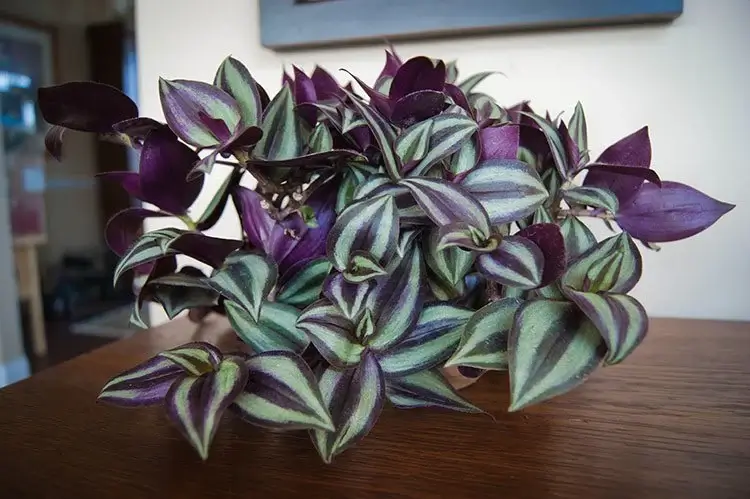
| Feature | Description |
|---|---|
| Scientific name | Tradescantia spp. |
| Common names | Wandering Jew, Inch Plant, Spiderwort Plant, and Zebrina Plant |
| Plant type | Herbaceous perennial |
| Foliage color | Comes in shades of green, purple, pink, and silver, often with stripes or markings |
| Leaf shape | Long, thin, and pointed, with a somewhat fleshy texture |
| Mature size | Can grow up to 2-3 feet (60-90 cm) long and wide, depending on the species and cultivar |
| Bloom time | Produces small, delicate flowers in shades of pink, purple, or white, but is mainly grown for its foliage |
| Light requirements | Prefers bright, indirect light or partial shade, but can tolerate some direct sun |
| Soil requirements | Well-draining soil, enriched with organic matter, and slightly acidic to neutral (pH 5.5-7.0) |
| Watering needs | Moderate watering, allow the soil to dry partially between watering sessions |
| Temperature | Thrives in warm temperatures between 60°F (15.5°C) and 85°F (29.5°C), but can tolerate cooler temperatures |
| Humidity | Prefers moderate to high humidity levels, and can be grown indoors or outdoors with proper care |
| Toxicity | Wandering Jew is considered mildly toxic to pets and humans if ingested, and can cause skin irritation in some people. |
5. Heuchera (Heuchera spp.)
Heuchera, also known as coral bells, are popular for their foliage. They come in a range of colors, including many with purple and green leaves. These plants are hardy and can be grown in a variety of climates.
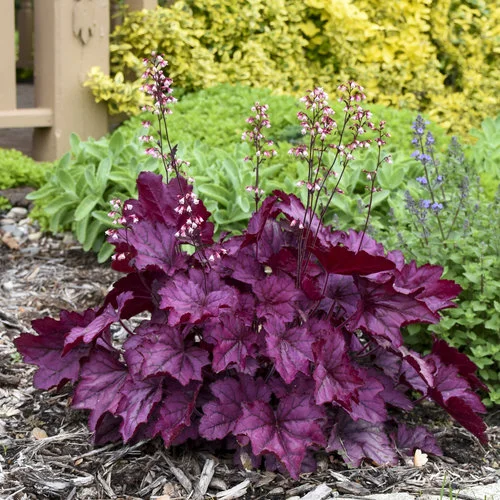
| Feature | Description |
|---|---|
| Scientific name | Heuchera spp. |
| Common names | Coral Bells, Alumroot |
| Plant type | Herbaceous perennial or evergreen subshrub |
| Foliage color | Comes in a wide range of colors, including green, purple, pink, red, yellow, and variegated |
| Leaf shape | Rounded, lobed or ruffled leaves that grow in a basal rosette |
| Mature size | Can range from a few inches to over 3 feet tall and wide, depending on the species and cultivar |
| Bloom time | Produces delicate, bell-shaped flowers on tall stems in the summer or early fall |
| Light requirements | Prefers partial shade to full sun, depending on the species and cultivar |
| Soil requirements | Well-draining soil, enriched with organic matter, and slightly acidic to neutral (pH 5.5-7.0) |
| Watering needs | Moderate watering, allow the soil to dry partially between watering sessions |
| Temperature | Thrives in cool to moderate temperatures, between 50°F (10°C) and 80°F (27°C) |
| Humidity | Prefers moderate humidity levels, but can tolerate drier conditions |
| Toxicity | Generally non-toxic to humans and pets, but can cause mild irritation if ingested. |
6. Caladium (Caladium spp.)
These tropical plants are known for their large, heart-shaped leaves. Many varieties feature purple and green patterns, making them a popular choice for gardens and indoor spaces.
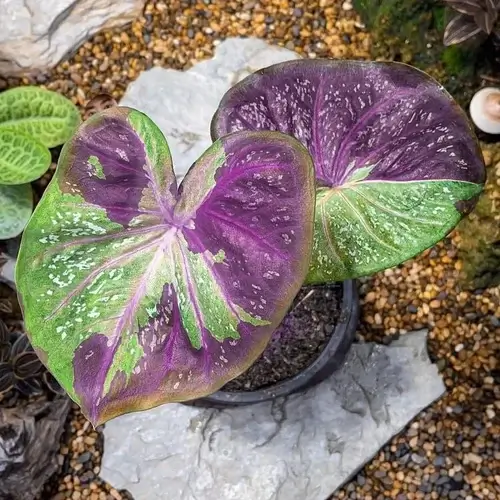
| Scientific name | Caladium spp. |
| Common names | Angel Wings, Elephant Ear, Heart of Jesus |
| Plant type | Herbaceous perennial that grows from tubers |
| Foliage color | Comes in a variety of colors, including green, pink, red, white, and variegated |
| Leaf shape | Large, heart-shaped leaves with pointed tips and prominent veins |
| Mature size | Can grow up to 2-3 feet (60-90 cm) tall and wide, depending on the species and cultivar |
| Bloom time | Produces small, inconspicuous flowers on tall spikes, but is mainly grown for its foliage |
| Light requirements | Prefers bright, indirect light or partial shade, but can tolerate some direct sun |
| Soil requirements | Well-draining soil, enriched with organic matter, and slightly acidic to neutral (pH 5.5-7.0) |
| Watering needs | Moderate to high watering needs, keep the soil consistently moist but not waterlogged |
| Temperature | Thrives in warm temperatures between 70°F (21°C) and 85°F (29°C), but can tolerate cooler temperatures |
| Humidity | Prefers high humidity levels, and can be grown indoors or outdoors with proper care |
| Toxicity | Caladium is considered toxic if ingested and can cause skin irritation in some people. |
7. Purple Heart (Setcreasea pallida)
This hardy plant features long, narrow leaves that are a deep purple color. It is easy to grow and can thrive in a range of lighting conditions.
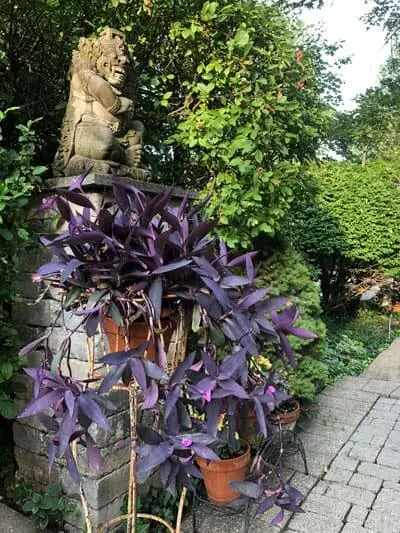
| Feature | Description |
|---|---|
| Scientific name | Tradescantia pallida |
| Common names | Purple Heart, Setcreasea |
| Plant type | Herbaceous perennial or annual |
| Foliage color | Long, narrow leaves that are purple or deep burgundy in color |
| Leaf shape | Long and pointed, with a slightly succulent texture |
| Mature size | Can grow up to 1-2 feet (30-60 cm) tall and 2-3 feet (60-90 cm) wide, depending on growing conditions |
| Bloom time | Produces small, pink or purple flowers on short stems in the summer or fall |
| Light requirements | Prefers bright, indirect light or partial shade, but can tolerate some direct sun |
| Soil requirements | Well-draining soil, enriched with organic matter, and slightly acidic to neutral (pH 5.5-7.0) |
| Watering needs | Moderate watering, allow the soil to dry partially between watering sessions |
| Temperature | Thrives in warm temperatures between 60°F (15°C) and 85°F (29°C) |
| Humidity | Prefers moderate to high humidity levels, but can tolerate drier conditions |
| Toxicity | Purple Heart is generally non-toxic to humans and pets, but can cause mild irritation if ingested. |
8. Red Rubin Basil (Ocimum basilicum ‘Red Rubin’)
This variety of basil features deep purple leaves with a hint of green. It is a popular choice for herb gardens and adds a unique twist to classic dishes.
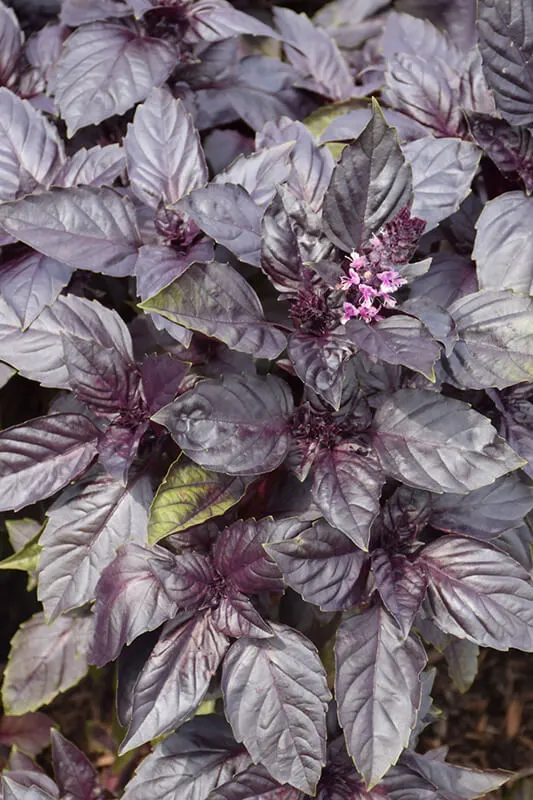
| Feature | Description |
|---|---|
| Scientific name | Ocimum basilicum ‘Red Rubin’ |
| Common names | Red Rubin Basil, Purple Basil |
| Plant type | Herbaceous annual or tender perennial herb |
| Foliage color | Dark red-purple, with a glossy texture |
| Leaf shape | Oval, with slightly serrated edges |
| Mature size | Can grow up to 2-3 feet (60-90 cm) tall, and up to 1-2 feet (30-60 cm) wide |
| Bloom time | Produces small, white or pink flowers in the summer, but is mainly grown for its foliage |
| Light requirements | Prefers full sun to partial shade, but can tolerate some shade |
| Soil requirements | Well-draining soil, enriched with organic matter, and slightly acidic to neutral (pH 6.0-7.0) |
| Watering needs | Moderate watering, keep the soil consistently moist but not waterlogged |
| Temperature | Thrives in warm temperatures between 60°F (15°C) and 85°F (29°C) |
| Humidity | Prefers moderate humidity levels, but can tolerate drier conditions |
| Toxicity | Red Rubin Basil is generally considered safe for human consumption. |
9. Lavender (Lavandula spp.)
While not all varieties of lavender have purple and green leaves, some, such as Lavandula x intermedia ‘Provence,’ do. This plant is prized for its fragrant flowers and foliage and is a popular choice for gardens and aromatherapy.

| Feature | Description |
|---|---|
| Scientific name | Lavandula spp. |
| Common names | Lavender |
| Plant type | Herbaceous perennial |
| Foliage color | Gray-green or silver-green leaves |
| Leaf shape | Narrow and elongated, with a slightly fuzzy texture |
| Mature size | Can grow up to 1-3 feet (30-90 cm) tall and wide, depending on the species and cultivar |
| Bloom time | Produces fragrant, lavender-purple or white flowers on tall spikes in the summer or fall |
| Light requirements | Prefers full sun, but can tolerate some shade |
| Soil requirements | Well-draining soil, enriched with organic matter, and slightly alkaline to neutral (pH 6.0-8.0) |
| Watering needs | Moderate watering, allow the soil to dry partially between watering sessions |
| Temperature | Thrives in warm temperatures between 60°F (15°C) and 80°F (27°C), and can tolerate some cold |
| Humidity | Prefers dry to moderate humidity levels |
| Toxicity | Lavender is generally considered safe for human consumption and non-toxic to pets. |

